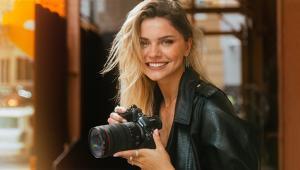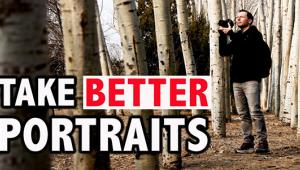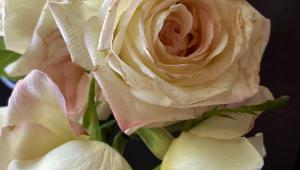Personal Project: A Close Encounter With History: A Student Project From Which We All Can Learn
“Our family came to America from Vietnam in the 1960s. When I first came to America, I came with fear. I was unsure of what I was going to find, my family had to be broken up. I had no clue if they had made it to America safely.”—Khanh Duong (Excerpt from Liana Bui’s student photo/oral history project.)

© Savannah Eby

Courtesy of Virginia Eby
High school student Liana Bui may not have fully known the trepidation her grandmother experienced when she first came to the United States from Vietnam in the 1960s, but she got to hear that history recently and the stories that changed her grandmother’s life.
The youth of today is either plugged into an iPod, linked to Facebook, mesmerized by a video game, or all of the above. It is no wonder that history, as a required high school subject, is viewed by the students as unrelated to their nanosecond world.
“History has nothing to do with me,” is a sentiment often heard from today’s youth.
At the same time, a 91 year old recently interviewed for oral history said, “I don’t know what I can offer. Why would you be interested in my stories?”
Her question echoes across the generation gap and becomes, in itself, the answer. As a former photography teacher, I wanted to help provide the bridge over that gap. That’s how one group of high school students learned that history doesn’t have to be boring.
Using photography and simple oral history techniques, history came alive for these students in a very personal way. And, not only was it surprisingly easy, anyone can do this for his own project or in a classroom setting.
Using photographs together with personal stories from grandparents, aunts, uncles, and other family members and friends help students learn more about the stories and events that shaped the past. The photographs create the visual appeal, the oral history adds the historical interest, and the production process provides the link between these two worlds.
The Plan
In a project called Talking Pictures, our class brought together these two seemingly disparate areas by combining history and photography in a way that demonstrates the importance of both, involving the student at the same time. This demonstrated that student-led projects can help promote a better understanding of family and heritage, and provide a greater shared knowledge through their work.
Our objective was simple: to understand how still photographs are used in other disciplines, the role photographs play in society and culture, and the emotional responses they evoke.

© Liana Bui

Courtesy of Khanh Duong
Photography
The class had already learned the basics of photography: exposure, light, portraiture, and digital components. And, thanks to my constant mantra of “learn what to include and exclude, and how to see,” they knew that making a good photograph called for more than simply pointing the camera and clicking off a few shots.
The photography steps included:
1. Each student had to be sure his camera was making crisp, clear, sharp photos. The students had a choice to use either the school’s digital cameras or their own.
2. The student was to make a series of environmental portraits of his subject, relating that person to his surroundings. The environment in which the photographs were made had to reveal something about the subject’s personality and character. After making the environmental portraits, the students were also encouraged to shoot close-ups—including tighter face shots, the hands, or some other feature.
3. Finally, the student asked for photographs from the subject’s younger days. The student then made a “photo of the photo” by getting as close as possible, or scanned the historic photo into the computer.
Oral History
The oral history section proved to be a bit more challenging, but the students quickly got the hang of it. The steps:
1. On a sheet of paper, each student recorded the name, age (if known), and location of the oldest relative or acquaintance. The relative or friend had to be easily accessible and live close enough for visits.
2. The students wrote three to six questions to ask the subject about what it was like in the “good old days.” Example: What did the subject do in his spare time? For entertainment? Did he watch television, and what were his favorite shows? Did he participate in sports? What were the most unusual stories?
3. The students were also to learn about the subject’s family heritage. Where did they come from and how did they end up in Central Florida?
4. We did not have audio recorders to use, so each student had to quickly write out what was said.
5. After some grumbling, the students were required to transcribe the first-person narrative. They were instructed not to correct grammar or put the information into their own words.
When completed, each student had 5x7” “then and now” photographs of their subjects, along with a typed narrative (usually one page).
The Display
The finished projects were displayed on a large bulletin board in the high school’s main hallway. A large world map served as the background. All of the students’ photos and their typed oral histories were strategically placed next to the world map. A piece of yarn leading from the photos to a spot on the map indicated the origin of their families. This is what made the project so meaningful for them. It made the connection between their family heritage and the photography more personal.
“I learned so much about my grandmother,” said Savannah Eby, a 17-year-old student who photographed and interviewed her grandmother. “She is losing her short-term memory, but she told me so many amazing stories about her childhood and how life was when she was growing up.”
Savannah’s revealing and intimate portrait was a powerful image.
“After I was married we bought an alligator,” her grandmother, Virginia Eby, said. “We kept him in a bathtub. Sometimes he would escape into the backyard and I would have to run and catch him. He eventually got too big to keep. We took him to Silver Springs to let him go.”
Liana Bui also chose to photograph her grandmother.
“At the beginning, when I was told about the assignment, I was a little confused about the point of the whole thing,” Liana said. “The assignment became clearer with new information.”
“Our family came to America from Vietnam in the 1960s. When I first came to America, I came with fear,” Liana’s grandmother, Khanh Duong, said. “I was unsure of what I was going to find, my family had to be broken up. I had no clue if they had made it to America safely. All I had were the clothes on my back and the few items and memories in my bag. Our first home was a small apartment with only one room for all 13 children of my husband and mine.”
“I learned that my grandma likes to collect silk,” Liana said. “She likes to get all her silk from all around the world. I learned that silk was a showing of wealth, which was a reason why my grandma liked to collect them. From the other students, I learned about different cultures and how diverse my class is.”
Both girls agreed that the final presentation is what made the project come together.
“I thought it was really cool,” Liana said. “Looking at all of us connected to the same place, and spreading out throughout the world, was pretty amazing.”
Savannah agreed.
“I thought the final project was much more exciting than I originally thought it was going to be. It was so cool having the string attach the picture to the country where our families were originally from.”
The Talking Pictures class assignment made history come alive in a very personal way for these students. It also taught them about heritage, art, and technology.
Maybe they won’t give up their iPods, but they did learn that history is cool, too.
Eric Dusenbery is a documentary photographer and photojournalist based in Florida. He has also taught photography and multimedia productions at a private high school in Orlando.

















































